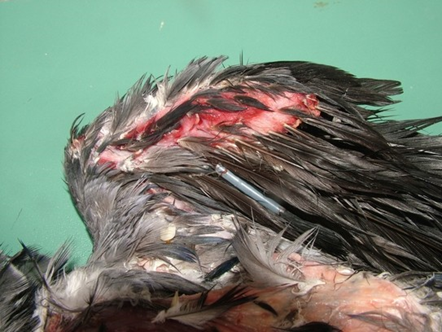Long Pham
Introduction
Polyomavirus in birds is an important issue for caged birds, which can cause large economic losses for pet stores and those that keep and breed birds. It was first recognized in budgerigars in the early 1980’s in Ontario, Canada (Bernier et al., 1981; Bernier et al., 1984) and in the southern parts of the United States (Davis et al., 1981). Since it was first recognized in budgerigars, the virus was known as the Budgerigar Fledgling Disease Virus. This virus is a nonenveloped DNA virus and is classified as a papovavirus (Davis et al., 1981). It was found that the Budgerigar Fledgling Disease Virus belongs to the polyomavirus virus family (Rott et al., 1988). It was also found that the virus infected many psittacine birds of different species, leading it to be called avian polyomavirus (Graham & Calnek, 1987). Avian polyomavirus is a significant issue as it highly common and can be found in most of the countries that raises and breeds psittacine birds (Müller & Nitschke, 1986; Pass, 1985).
Diagnosis
Avian polyomavirus disease can be seen to affect three types of birds: budgerigars, nonbudgerigar parrots, and lovebirds.
For budgerigars, avian polyomavirus disease causes death usually for nestlings that are from 10 to 25 days of age (Davis et al., 1981). The signs in birds at death includes skin discoloration, areas of hemorrhage (Figure 1), fluid in the abdomen, stunted growth, abnormal feather development, and an enlarged liver (Phalen, 1998). In some cases, the avian polyomavirus affects a part of the brain, causing the birds to have head tremors (Phalen, 1998). Testing in these birds have showed that viral inclusion bodies were present in multiple places such as the kidney, spleen, liver, brain, heart, esophagus, skin, and the feather follicles (Bernier et al., 1984; Davis et al., 1981; Müller & Nitschke, 1986). However, not every infected budgerigars will die or show signs of being infected. Other budgerigars will not be able to develop their primary and secondary wing feathers and may even not be able to develop their tail feathers (Hirai et al., 1984). It should be noted that it seems that the disease may not affect all budgerigars in the same way, as a study in the US has showed that English budgerigars were rarely infected when kept near actively infectious birds (Phalen et al., 1997).

For nonbudgerigar parrots, they are also susceptible to the avian polomavirus, with some breeds being more than others and depending on the ages. For conures, death can occur at less than six weeks of age, while for macaws and eclectus parrots, it can occur at less than 14 weeks of age (Phalen, 1998). Nestlings infected with the disease can appear healthy with just a few premonitory symptoms, but then die suddenly (Phalen, 1998). While those nestlings with symptoms can die in just a few hours (Phalen, 1998). In the hours before death, the birds may show weakness, appear pale, have bruises, and may have delayed crop emptying (Phalen, 1998). A researcher was able to predict which bird would die within 24 hours by pulling out growing feathers and seeing if the bird bled significantly (Clubb & Davis, 1984). After death examination of the birds and viral inclusion bodies locations were similar to budgerigars.
For lovebirds, it is similar to as in budgerigar. However, the main difference is that the affected age is up to 1 year of age (Pass, 1985). It is not known for the reason for this age susceptibility, but some of the older birds do have a concurrent infection of the psittacine beak and feather disease virus, which may let the avian polyomavirus to progress (Phalen, 1998).
While many birds can be infected with the avian polyomavirus, only some of these birds will develop the disease (Phalen et al., 1997). In most cases, these adult birds develop the disease due to being immunosuppressed from having psittacine beak and feather disease virus (Latimer et al., 1993). For the asymptomatic birds, they are still infectious and shed the virus for a certain period of time (Phalen et al., 1997). The period of time virus shedding can depend on the species and the age of the bird. Shedding of the virus can be from feces and dander (feather and skin) for around 6 months (Phalen et al., 1993). At sexual maturity or the first breeding cycle, virus shedding stops and therefore, young birds should be the main source of the virus spreading to other birds (Phalen, 1998).
Infected birds can be tested for avian polyomavirus virus through the serologic test of the blood for antibodies. For budgerigars, they can have antibodies to the virus for life, while other bird species can have it from 6 months to 3 years (Phalen et al., 1997).
Another method that can be used for diagnosis is conducting polymerase chain reaction (PCR) on blood or cloacal swabs. This PCR is a highly sensitive method of detection. However, the high sensitivity could also easily cause false positives because it is possible to contaminate the sample from the contaminated environment.
Treatment and Disease Control
Currently, there are no treatments or cure for avian polyomavirus infections. Supportive care can be given, however, the disease progression can occur too quickly to have any effect.
Preventative measures for controlling this disease involves testing, monitoring movement, separation, and thorough disinfection. Vaccination can also help in preventing avian polyomavirus diease.
In general, if new birds are to be brought into an aviary, screening the bird for the disease can prevent an outbreak from occurring. If birds are to be moved out and returned into the aviary, they should be quarantined and tested before they can be around other birds. For nestlings, they should be separated from other birds as they are more susceptible until weaned. Proper hygiene and cleaning can help a little, but in the case of an outbreak, the environment should be thoroughly disinfected enough before birds can be brought back into the area.
References
Bernier, G., M. Morin, and G. Marsolais. 1981. A generalized inclusion body disease in the Budgerigar (melopsittacus undulatus) caused by a papovavirus-like agent. Avian Diseases 25:1083-1092.
Bernier, G., M. Morin, and G. Marsolais. 1984. Papovavirus induced feather abnormalities and skin lesions in the budgerigar: clinical and pathological findings. Can Vet J 25:307–310.
Clubb, S. L., and R. B. Davis. 1984. Outbreak of a papova-like viral infection in a psittacine nursery – a retrospective view. Pages 121–129 in. Proceedings of International Conference on Avian Medicine. Toronto.
Davis, R. B., L. H. Bozeman, D. Gaudry, O. J. Fletcher, P. D. Lukert, and M. J. Dykstra. 1981. A viral disease of fledgling budgerigars. Avian Diseases 25:179–183.
Graham, D. L., and B. W. Calnek. 1987. Papovavirus infection in hand-fed parrots: Virus isolation and pathology. Avian Diseases 31:398–410.
Hirai, K., H. Nonaka, H. Fukushi, S. Shimakura, T. Masegi, and T. Mizoguchi. 1984. Isolation of a papovavirus-like agent from young budgerigars with feather abnormalities. The Japanese Journal of Veterinary Science 46:577–582.
Latimer, K. S., F. D. Niagro, R. P. Campagnoli, B. W. Ritchie, D. A. Pesti, and W. L. Steffens. 1993. Diagnosis of concurrent avian polyomavirus and psittacine beak and feather disease virus infections using DNA probes. Journal of the Association of Avian Veterinarians 7:141–146.
Müller, H., and R. Nitschke. 1986. A polyoma-like virus associated with an acute disease of fledgling budgerigars (melopsittacus undulatus). Medical Microbiology and Immunology 175:1–13.
Pass, D. A. 1985. A papova-like virus infection of lovebirds (Agapornis sp). Australian Veterinary Journal 62:318–319.
Phalen, D. N., V. G. Wilson, and D. L. Graham. 1993. Organ distribution of avian polyomavirus DNA and virus-neutralizing antibody titers in healthy adult budgerigars. American Journal of Veterinary Research 54:2040–2047.
Phalen, D. N., V. G. Wilson, and D. L. Graham. 1997. Prevalence of Neutralizing Antibody and Virus Shedding in Psittacine Birds Infected with Avian Polyomavirus. Journal of Avian Medicine and Surgery 11:98–104.
Phalen, D. N. 1998. Avian Polyomavirus: My Thoughts. American Federation of Aviculture Watchbird 25:28–39.
Rott, O., M. Kröger, H. Müller, and G. Hobom. 1988. The genome of budgerigar fledgling disease virus, an avian polyomavirus. Virology 165:74–86.
Samanta, I., and S. Bandyopadhyay. 2017. Infectious diseases. Pet bird diseases and care 13–166.



